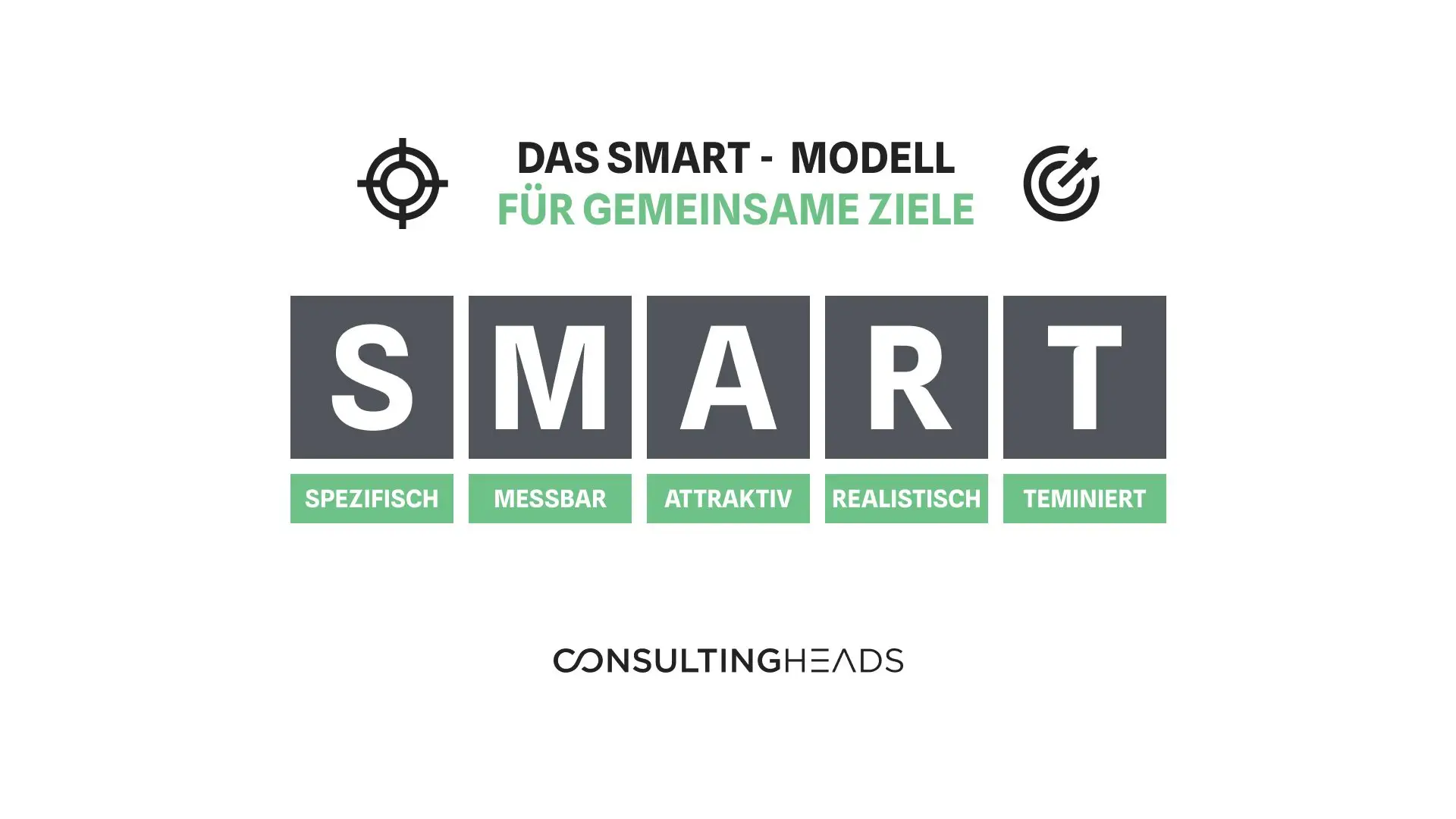SMART goals are the be-all and end-all for effective goal setting and achievement in companies. They not only set the direction, but also ensure measurable results. Originally from the management by Objectives (MbO), a method that sets clear, understandable goals for management and management and employeesinside SMART goals have long since proven their effectiveness. They perfectly complement the concept of Objectives and Key Results (OKR)which focuses on ambitious goals and their measurable results. By linking SMART goals with MbO and OKR, a powerful set of tools is created to not only define individual and team-related goals, but also to achieve them in line with the overarching corporate goals. SMART stands for specific, measurable, achievable, relevant and time-bound – principles that help to turn vague intentions into concrete plans for success. In the following, concrete examples are used to illustrate the SMART goals and show how they can be implemented in practice.
What is the SMART method?
SMART goals or the SMART method are the foundation for goal-oriented work and clear future planning in companies and projects. The origin of the SMART principle can be traced back to George T. Doran, a business planning consultant who published the article “There’s a SMART way to write management’s goals and objectives“ published. In this article, Doran introduced the concept of SMART goals for the first time.
The core message of the SMART concept is the transformation of general and abstract goals into concrete, tangible targets based on five central criteria: They must be specific, measurable, attractive, realistic and time-bound. Each of these criteria plays a decisive role in the process of formulating and achieving objectives:

A closer look at the individual aspects of the SMART method:
Specific (Specific)
Goal without SMART: “I want to earn more money.”
SMART goal: “I want to increase my income by acquiring three new freelance projects within the next six months.”
A specific goal clarifies the five “W” questions: Who is involved? What do I want to achieve? Where will it be implemented? When does it take place? Why is this goal important? This clarification helps to sharpen the focus and avoid misunderstandings. Instead of saying “I want to exercise more”, a specific goal could be: “I want to jog three times a week after work for 30 minutes to improve my stamina.”
Measurable
Goal without SMART: “I want to get fitter.”
SMART goal: “I want to improve my running performance by reducing my 5 km time by 5 minutes within the next three months.”
A measurable goal makes it possible to record progress in concrete terms and to assess whether and when the goal has been achieved. Measurability can be defined by numbers, percentages or other clear indicators. For example: “I want to increase my customer satisfaction rate by 10% by the end of the quarter.” This approach makes it easier to set milestones and maintain motivation.
Attractive
Goal without SMART: “I should expand my network.”
SMART goal: “I want to expand my professional network by attending five industry-specific online networking events by the end of the quarter to improve my career opportunities.”
An attractive goal is inspiring and motivating. It reflects a true need or desire that is strong enough to drive through challenges. Attractiveness in goals creates an emotional bond and increases the willingness to make an effort and overcome hurdles. An attractive goal for someone might be: “I would like to become fluent in an additional language within the next two years to enrich my travel experiences and improve my communication skills in an international working environment.”
Realistic (Realistic)
Goal without SMART: “I want to write a book.”
SMART goal: “I plan to write the first five chapters of my novel within the next four months by spending five hours a week on it.”
Realistic goals are in line with the available resources, skills and circumstances. They should be ambitious, but not so far-fetched that they become almost impossible to achieve. A realistic goal also takes into account external factors beyond your control and estimates feasibility based on an honest assessment of the current situation and potential obstacles.
Scheduled (time-bound)
Goal without SMART: “I want to learn a new language.”
SMART goal: “I want to acquire a basic knowledge of Spanish by completing an online language course by the end of the year and practicing at least once a week.”
A goal with a fixed time frame creates urgency and helps to set priorities. It defines the date by which the goal is to be achieved, which in turn sets a clear deadline and thus facilitates planning and time management. A scheduled objective could be: “I would like to complete my specialist book by the end of this year and submit it for publication.” This helps to strategically plan tasks and continuously monitor progress.
By applying these five principles, goals can be defined in such a way that they are not only clear and focused, but also have a realistic chance of success. This not only promotes personal development and a sense of achievement, but also contributes to a more effective and efficient way of working.
5 concrete SMART goals Examples for different areas
The application of the SMART method can be very helpful across different contexts, from company and team goals to individual professional and personal goals. Here are examples for each area:
CORPORATE GOALS
- Specific: Increase market share in the sector.
- Measurable: The target is an increase of 5% within one year.
- Attractive: The goal is to position the company as a market leader and increase its enterprise value.
- Realistic: Based on market analyses and previous growth rates, the target is achievable.
- Deadline: The deadline is the end of the financial year.
SMART target: “We plan to increase our market share in the financial technology industry by 5% by investing in new technologies and optimizing our sales strategies by the end of the next financial year.”
TEAM GOALS
- Specific: Increase in customer satisfaction.
- Measurable: Increase in customer satisfaction rating by 10 points.
- Attractive: Higher customer satisfaction leads to more recommendations and loyal customers.
- Realistic: Achievable through improved customer service and faster feedback management.
- Scheduled: Within the next 6 months.
SMART target: “Our team aims to increase customer satisfaction ratings by 10 points by improving our feedback management system and reducing response times within the next 6 months.”
FREELANCE GOALS
- Specific: Expansion of the range of services.
- Measurable: Addition of two new services to the portfolio.
- Attractive: New services attract a broader customer base.
- Realistic: Can be implemented with existing expertise and minimal additional resources.
- Scheduled: By the end of the quarter.
SMART Objective: “I plan to add two new areas to my service offering by the end of this quarter, building on my existing knowledge to increase my target client base.”
PROFESSIONAL GOALS
- Specific: Obtaining a higher position in the company.
- Measurable: Promotion to team leader.
- Attractive: The new position offers more responsibility and better pay.
- Realistic: Possible with three years of experience and positive feedback.
- Scheduled: Within the next year.
SMART goal: “I aim to be promoted to the position of team leader within the next year through continuous performance improvement and participation in leadership seminars.”
PERSONAL GOALS
- Specific: Improvement of physical fitness.
- Measurable: Loss of 10 kg body weight.
- Attractive: Better health and well-being.
- Realistic: Achievable with a structured nutrition and training plan.
- Scheduled: Within 6 months.
SMART goal: “I intend to improve my well-being by losing 10 kg within the next 6 months, through a healthy diet and regular exercise three times a week.”
These examples show how the SMART method can help to clearly define goals in different contexts and increase the likelihood of achieving them.
Checklist: What are the advantages of SMART goals?
The use of SMART goals offers numerous advantages that can be of great benefit in both a professional and personal context. Here are some of the most important advantages:
- Clarity and focus
SMART goals promote clarity and precision in goal setting. By formulating them specifically, they help to focus on the essentials and direct attention and resources towards achieving precisely defined results. This prevents you from getting lost in vague intentions and enables targeted planning and execution. - Measurability and progress monitoring
By defining measurable criteria, SMART goals enable an objective assessment of progress. This makes it easier to monitor developments and identify deviations from the planned course at an early stage so that adjustments can be made in good time. The ability to quantify success also has a motivating and reinforcing effect. - Accessibility and motivation
SMART goals are designed to be achievable and realistic. This ensures that individuals and teams set themselves goals that are challenging but still within reach. The realization that a goal is achievable has a strong motivating effect and promotes commitment and the willingness to make an effort. - Relevance and alignment
Taking relevance into account ensures that the targets set are in line with overarching plans, values and long-term visions. This helps to ensure that resources are used effectively and prevents work and effort from being invested in goals that ultimately have little significance for personal or organizational development. - Time constraints and urgency
Setting a clear time frame for achieving goals creates urgency and prevents procrastination. Time-based targets help to prioritize tasks, facilitate time planning and promote continuous progress monitoring. They ensure that initiatives and projects have a defined beginning and a clear end, which helps to increase efficiency. - Promotion of personal responsibility and self-management
The structure of SMART goals encourages individuals to take responsibility for their own goal achievement. It supports effective self-management and self-reflection by providing a clear basis for evaluating one’s own performance and setting future goals.
Overall, SMART goals help to increase the chances of success by providing a solid foundation for goal setting and tracking. They are an essential tool for personal growth, improved performance and the successful implementation of initiatives and projects.
SMART goals defined and now?
Once you have defined your SMART goals, the next challenge is to link them to the day-to-day work of your team. Many companies rely on emails, spreadsheets and face-to-face meetings to monitor progress, which can lead to confusion. Effective communication and regular review of objectives are crucial to ensure that everyone involved is on the same page and work is progressing in a targeted manner. It is important to keep the goals visible and closely linked to day-to-day work in order to promote motivation and focus.
Are you looking for expert support in implementing Management by Objectives (MbO), Objectives and Key Results (OKR) or the SMART method? At consultingheads, we offer customized advice and practical solutions to help you achieve your strategic goals and lead your teams to success. With our expertise and a network of over 12,500 consultants and interim experts, we are ideally positioned to provide you with effective support in these key areas. Let’s turn your challenges into opportunities together.
Do you need expert support with the implementation of MbO, OKR or the SMART method?
At consultingheads, we offer customized advice and practical solutions to help you achieve your strategic goals and lead your teams to success.






